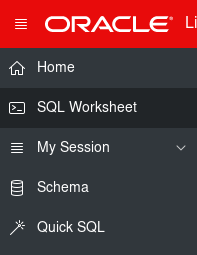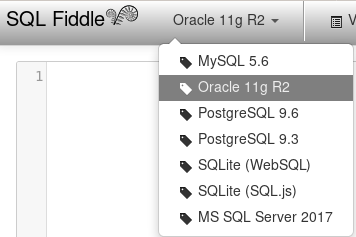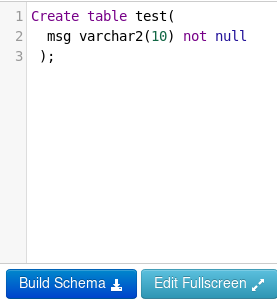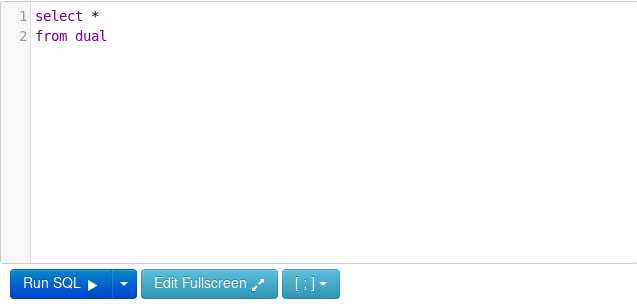Sql fiddle что это
Выполнение SQL. Облачные сервисы
Для того, чтобы начать работу с БД(причем любой), она должна быть где-либо установлена, и к ней должен быть доступ на подключение и выполнение запросов.
LiveSQL
Работать с livesql очень просто; опишем стандартные шаги, необходимые для запуска своих sql-запросов.
Входим под своей учеткой, после чего в левом боковом меню выбираем «SQL WorkSheet»:
В открывшемся окне вводим наши SQL-запросы:
Чтобы выполнить запрос, написанный в SQL Worksheet, нажимаем на кнопку «Run», которая находится сверху над полем для ввода текста запроса:
Впринципе, работа с LiveSQL не должна вызывать вопросов, но на всякий случай вот видео с youtube(на английском) c подробным описанием работы в нем: https://youtu.be/4oxsxJQQC-s.
SQL Fiddle
Далее будет описано, как работать с данным сервисом.
Сначала заходим на SQL Fiddle.
Перед началом работы SQL Fiddle требует создания схемы. Это значит, что таблицы, с которыми нужно работать, должны быть созданы на этом этапе. Вводим текст ddl-скрипта (скрипта, который создает таблицы и др. объекты БД), после чего нажимаем на кнопку «Build Schema»:
После того, как схема будет построена, можно выполнять SQL-запросы. Они вводятся в правой панели(она называется «Query Panel»). Чтобы выполнить запрос, нажимаем на кнопку «Run Sql»:
Результаты выполнения запросов отображаются под панелями создания схемы и ввода sql:
Запуск примеров учебника
Запускать примеры из учебника можно в любой среде. Тем не менее, в силу того, что тема транзакций будет рассматриваться в самом конце, лучше всего(и удобнее) использовать сервис LiveSQL.
В дальнейшем, при изучении PL/SQL, придется выбрать какую-нибудь IDE, но при изучении базового SQL это необязательно.
About SQL Fiddle
A tool for easy online testing and sharing of database problems and their solutions.
Who should I contact for help/feedback?
There are two ways you can get in contact:
What am I supposed to do here?
If you do not know SQL or basic database concepts, this site is not going to be very useful to you. However, if you are a database developer, there are a few different use-cases of SQL Fiddle intended for you:
You want to compare and contrast SQL statements in different database back-ends. SQL Fiddle easily lets you switch which database provider (MySQL, PostgreSQL, MS SQL Server, Oracle, and SQLite) your queries run against. This will allow you to quickly evaluate query porting efforts, or language options available in each environment.
You do not have a particular database platform readily available, but you would like to see what a given query would look like in that environment. Using SQL Fiddle, you don’t need to bother spinning up a whole installation for your evaluation; just create your database and queries here!
How does it work?
The Schema DDL that is provided is used to generate a private database on the fly. If anything is changed in your DDL (even a single space!), then you will be prompted to generate a new schema and will be operating in a new database.
As you create schemas and write queries, unique URLs that refer to your particular schema and query will be visible in your address bar. You can share these with anyone, and they will be able to see what you’ve done so far. You will also be able to use your normal browser functions like ‘back’, ‘forward’, and ‘reload’, and you will see the various stages of your work, as you would expect.
What differences are there between the various database options?
Aside from the differences inherent in the various databases, there are a few things worth pointing out about their implementation on SQL Fiddle.
MySQL only supports queries which read from the schema (selects, basically). This is necessary due to some limitations in MySQL that make it impossible for me to ensure a consistent schema while various people are fiddling with it. The other database options allow the full range of queries that the back-end supports.
SQLite runs in the browser; see below for more details.
What’s up with that [ ; ] button under each panel?
This obscure little button determines how the queries in each of the panels get broken up before they are sent off to the database. This button pops open a dropdown that lists different «query terminators.» Query terminators are used as a flag to indicate (when present at the end of a line) that the current statement has ended. The terminator does not get sent to the database; instead, it merely idicates how I should parse the text before I execute the query.
Oftentimes, you won’t need to touch this button; the main value this feature will have is in defining stored procedures. This is because it is often the case that within a stored procedure’s body definition, you might want to end a line with a semicolon (this is often the case). Since my default query terminator is also a semicolon, there is no obvious way for me to see that your stored procedure’s semicolon isn’t actually the end of the query. Left with the semicolon terminator, I would break up your procedure definition into incorrect parts, and errors would certainly result. Changing the query terminator to something other than a semicolon avoids this problem.
Why are there two strange-looking options for SQLite?
SQLite is something of a special case amongst the various database types I support. I could have implemented it the same way as the others, with a backend host doing the query execution, but what fun is that? SQLite’s «lite» nature allowed for some interesting alternatives.
Together, these two options allow SQLite to run within any decent browser *cough*IE*cough*. If someone links you to a SQLite fiddle that your browser doesn’t support, just switch over to the other option and build it using that one. If neither works, then get a better browser.
Who built this site, and why?
He found JS Fiddle to be a great tool for answering javascript / jQuery questions, but he also found that there was nothing available that offered similar functionality for the SQL questions. So, that was his inspiration to build this site. Basically, he built this site as a tool for developers like me to be more effective in assisting other developers.
How is the site paid for?
ZZZ Projects started to pay for the hosting in 2017 before taking the ownership in 2018. We have some great plan to make SQL Fiddle even more friendly user, and we welcome any contribution.
Source Code
If you are interested in the fine details of the code behind SQL Fiddle and exactly how it is deployed, it is all available on github
What platform is it running on?
This site uses many different technologies. The primary ones used to provide the core service, in order from client to server are these:
| Title | Description |
|---|---|
| RequireJS js | JavaScript module loader and code optimizer. |
| CodeMirror js | For browser-based SQL editing with text highlighting. |
| Bootstrap css | Twitter’s CSS framework (v2). |
| LESS css | CSS pre-processor. |
| Backbone.js js | MV* JavaScript framework. |
| Handlebars.js js | JavaScript templating engine. |
| Lodash.js js | Functional programming library for Javascript. |
| Date.format.js js | Date formatting JavaScript library. |
| jQuery js | AJAX, plus misc JS goodness. (Also jq plugins Block UI and Cookie ). |
| html-query-plan js | XSLT for building rich query plans for SQL Server. |
| Varnish backend | Content-caching reverse proxy. |
| Vert.x backend | Open Source Java-based Application Server. |
| PostgreSQL db | Among others, of course, but PG is the central database host for this platform. |
| Grunt devops | Javascript task runner, config and frontend build automation. |
| Maven devops | Dependency management, backend build automation. |
| Docker devops | VM management. |
| Amazon AWS hosting | Cloud Hosting Provider. |
| GitHub devops hosting | Git repository, collaboration environment. |
This list doesn’t include the stacks used to run the database engines. Those are pretty standard installs of the various products. For example, I’m running a Windows 2008 VPS running SQL Server 2014 and Oracle, and various Docker images running the others.
Язык запросов SQL
Язык запросов SQL
База данных — централизованное хранилище данных, обеспечивающее хранение, доступ, первичную обработку и поиск информации.
Базы данных разделяются на:
SQL (Structured Query Language) — представляет из себя структурированный язык запросов (перевод с английского). Язык ориентирован на работу с реляционными (табличными) базами данных. Язык прост и, по сути, состоит из команд (интерпретируемый), посредством которых можно работать с большими массивами данных (базами данных), удаляя, добавляя, изменяя информацию в них и осуществляя удобный поиск.
Для работы с SQL кодом необходима система управления базами данных (СУБД), которая предоставляет функционал для работы с базами данных.
Система управления базами данных (СУБД) — совокупность языковых и программных средств, предназначенных для создания, ведения и совместного использования БД многими пользователями.
Обычно, для обучения используется СУБД Microsoft Access, но мы будем использовать более распространенную в веб сфере систему — MySQL. Для удобства будет использовать веб-интерфейс phpmyadmin или онлайн сервис для построения sql запросов sql fiddle, принцип работы с которыми описан ниже.
Каждый столбец должен иметь свой тип данных, т.е. должен быть предназначен для внесения данных определенного типа. Типы данных в MySQL описаны в одном из уроков данного курса.
Составляющие языка SQL
Язык SQL состоит из следующих составных частей:
1.
Язык манипулирования данными состоит из 4 главных команд:
Язык определения данных используется для создания и изменения структуры базы данных и ее составных частей — таблиц, индексов, представлений (виртуальных таблиц), а также триггеров и сохраненных процедур.
Мы будем рассматривать лишь несколько из основных команд языка. Ими являются:
Язык управления данными используется для управления правами доступа к данным и выполнением процедур в многопользовательской среде.
Как сделать sql запрос в phpmyadmin
Создание базы данных в phpmyadmin
Для начала необходимо выполнить первые два пункта из предыдущего задания.
Затем:
Работа в сервисе sql fiddle
Онлайн проверка sql запросов возможна при помощи сервиса sqlFiddle.
Самый простой способ организации работы состоит из следующих этапов:
Еще пример: 
Теперь некоторые пункты рассмотрим подробнее.
Создание таблиц:
* для тех, кто незнаком с синтаксисом — просто скопировать полностью код и вставить в левое окошко сервиса
* урок по созданию таблиц в языке SQL далее
В результате получим таблицы с данными:
Отправка запроса:
Для того чтобы протестировать работоспособность сервиса, добавьте в правое окошко код запроса.
SELECT * FROM `teachers` WHERE `name` = ‘Иванов’;
На дальнейших уроках SQL будет использоваться та же схема, поэтому необходимо будет просто копировать схему и вставлять в левое окно сервиса.
Онлайн визуализации схемы базы данных
Для онлайн визуализации схемы базы данных можно воспользоваться сервисом https://dbdesigner.net/:
10 лучших онлайн SQL редакторов
Несмотря на то, что на рынке доступны различные типы инструментов SQL, вы должны оценить и выяснить, какой из них лучше всего подходит для каких обстоятельств. Некоторые инструменты предлагают высокую производительность с отличным интерфейсом и множеством функций, в то время как другие ограничены до некоторой степени.
#1) Datapine SQL Editor
Datapine появился с видением, позволяющим менеджерам и лицам, принимающим решения, генерировать идеи и отчеты для эффективного управления своим бизнесом. Кроме того, отчеты KPI datapine включают в себя инструмент визуализации данных, который позволяет создавать представление данных таким образом, чтобы каждый пользователь мог их понять.
Кроме того, эти данные и отчеты по датапатинам можно легко обмениваться с помощью автоматизации в отчетах.
Преимущества
Цены
Datapine предлагает четыре различных типа тарифных планов, как показано ниже:
#2) SQL Fiddle
SQL Fiddle – еще один лучший инструмент. Если вы посмотрите на этот веб-сайт, вы увидите, что это редактор SQL с открытым исходным кодом, который поддерживает множество различных типов баз данных. Основная цель этого инструмента состояла в том, чтобы провести простое онлайн-тестирование и поделиться проблемами и связанными решениями базы данных.
Преимущества:
Pricing
Как вы можете видеть на картинке выше, проекты ZZZ просят вас внести свой вклад в их проект. ZZZ проектирует собственный SQL Fiddle и, поскольку они предоставляют вам бесплатный редактор исходного кода, они просят (не обязательно) внести вклад в их веб-сайт для поддержания и покрытия регулярных расходов.
#3) DBHawk
Преимущества
Цены
DBHawk предлагает два тарифных плана:
#4) SQuirreL SQL
SQuirreL SQL – еще один инструмент с открытым исходным кодом для клиентов. Он использует драйвер JDBC для взаимодействия с базами данных. Этот редактор SQL был полностью разработан на языке JAVA и должен работать на любой платформе, поддерживающей JVM.
Преимущества
Цены
SQuirreL SQL не определяет тарифные планы, поскольку это бесплатный встроенный редактор с открытым исходным кодом.
#5) Jdoodle Online SQL Editor
Jdoodle – это онлайн-инструмент для простого и безопасного выполнения коротких строк. Его цель – предоставить платформу для создания новых проектов для шорткодов и их простого исполнения. Он поддерживает такие языки, как PHP, Ruby, Python, HTML и т. Д. Он поддерживает базы данных MongoDB и MySQL.
Преимущества
Цены: свяжитесь с ними напрямую для получения информации о ценах.
#6) DB Comparer
DB Comparer – это инструмент для профессионалов, которым необходимо сравнивать базы данных, таблицы, графики, диаграммы и т. Д. Он имеет простой и понятный пользовательский интерфейс, который отображает четкое сравнение баз данных. Для администратора базы данных его можно рассматривать как идеальный инструмент для сравнения и получения точных результатов.
Преимущества
Цены: DB Comparer – бесплатный инструмент для сравнения баз данных.
#7) Oracle Live SQL
Oracle Live SQL больше фокусируется на тестировании и обмене данными. Его недостатком является то, что другие базы данных не поддерживаются, пока вы не используете стандартный SQL. Инструмент предоставляет вам учебное пособие и полную документацию. Было бы хорошо использовать инструмент Oracle, поскольку он также предоставляет примеры данных для PHP и Java.
Преимущества
Цены: Практически все продукты Oracle можно бесплатно загрузить и использовать.
#8) DBeaver
DBeaver – это сообщество, в котором несколько разработчиков, программистов SQL, аналитиков данных и администраторов данных работают как единое сообщество. Он также предоставляет пользователям бесплатный мультиплатформенный инструмент для работы с базами данных.
DBeaver поддерживает все распространенные типы баз данных, такие как MySQL, Oracle, DB2, SQLite, Sybase, Derby и многие другие.
Лучшая часть DBeaver – это то, что он поддерживает диаграммы ER для определения отношений и сравнения структуры базы данных. В дополнение к этому, вы также можете перейти к поиску данных и метаданных.
Преимущества
Цены
DBeaver в основном предлагает три типа тарифных планов на основе продолжительности, как в месяц / в год. План точно такой же, но разница заключается в сроке погашения плана.
#9) Microsoft SQL Server Management Studio Express
Этот инструмент поставляется с Management Studio Express, которая является бесплатной версией Microsoft. SSMSE (SQL Server Management Studio Express) был впервые запущен с SQL 2005 с целью предоставления таких услуг, как администрирование, управление и конфигурирование данных.
Также обратите внимание, что этот инструмент не поддерживает такие службы, как службы интеграции, службы отчетов, службы анализа, уведомления и т. Д.
Преимущества
Цены: Цены на этот инструмент абсолютно бесплатны.
#10) Visual Expert
Преимущества
Цены: Нужно заполнить форму, чтобы получить расценки от Visual Expert.
Вывод
SQL является одним из наиболее часто используемых языков для администрирования, управления и контроля данных в базе данных. Нужно понимать, что такое SQL, только тогда человек сможет понять его дальнейшее функционирование.
Кроме того, если вы являетесь разработчиком или программистом SQL, вы должны четко определить количество инструментов, доступных на рынке. Следовательно, это сложная задача, чтобы выбрать или выбрать какой-либо конкретный инструмент из лучших доступных вариантов.
В конечном счете, вы должны найти идеальный инструмент, который лучше всего подходит для вашей работы и потребностей. Таким образом, просто не забудьте оценить и рассмотреть факторы каждого инструмента. Все это определенно гарантирует, что разработчики не будут тратить впустую время и продолжать работать с инструментом вовремя.
About SQLFiddle.com
A tool for easy online testing and sharing of database problems and their solutions.
What am I supposed to do here?
If you do not know SQL or basic database concepts, this site is not going to be very useful to you. However, if you are a database developer, there are a few different use-cases of SQL Fiddle intended for you:
You want to compare and contrast SQL statements in different database back-ends. SQL Fiddle easily lets you switch which database provider (MySQL, PostgreSQL, MS SQL Server, Oracle, and SQLite) your queries run against. This will allow you to quickly evaluate query porting efforts, or language options available in each environment.
You do not have a particular database platform readily available, but you would like to see what a given query would look like in that environment. Using SQL Fiddle, you don’t need to bother spinning up a whole installation for your evaluation; just create your database and queries here!
SQL Fiddle : SQL Online Practice Tool
AllzHere has made a nice instructional video and blog post for getting started with SQL Fiddle.
How does it work?
The Schema DDL that is provided is used to generate a private database on the fly. If anything is changed in your DDL (even a single space!), then you will be prompted to generate a new schema and will be operating in a new database.
As you create schemas and write queries, unique URLs that refer to your particular schema and query will be visible in your address bar. You can share these with anyone, and they will be able to see what you’ve done so far. You will also be able to use your normal browser functions like ‘back’, ‘forward’, and ‘reload’, and you will see the various stages of your work, as you would expect.
What differences are there between the various database options?
Aside from the differences inherent in the various databases, there are a few things worth pointing out about their implementation on SQL Fiddle.
MySQL only supports queries which read from the schema (selects, basically). This is necessary due to some limitations in MySQL that make it impossible for me to ensure a consistent schema while various people are fiddling with it. The other database options allow the full range of queries that the back-end supports.
Versions of various databases that are either older or newer than the current stable release for that product are hosted by Jack Douglas in his server environment. This means that some of the schema building / query execution actions may be a bit slower for these options, as there is more network latency between my web server and his VMs.
SQLite runs in the browser; see below for more details.
What’s up with that [ ; ] button under each panel?
This obscure little button determines how the queries in each of the panels get broken up before they are sent off to the database. This button pops open a dropdown that lists different «query terminators.» Query terminators are used as a flag to indicate (when present at the end of a line) that the current statement has ended. The terminator does not get sent to the database; instead, it merely idicates how I should parse the text before I execute the query.
Oftentimes, you won’t need to touch this button; the main value this feature will have is in defining stored procedures. This is because it is often the case that within a stored procedure’s body definition, you might want to end a line with a semicolon (this is often the case). Since my default query terminator is also a semicolon, there is no obvious way for me to see that your stored procedure’s semicolon isn’t actually the end of the query. Left with the semicolon terminator, I would break up your procedure definition into incorrect parts, and errors would certainly result. Changing the query terminator to something other than a semicolon avoids this problem.
Why are there two strange-looking options for SQLite?
SQLite is something of a special case amongst the various database types I support. I could have implemented it the same way as the others, with a backend host doing the query execution, but what fun is that? SQLite’s «lite» nature allowed for some interesting alternatives.
Together, these two options allow SQLite to run within any decent browser *cough*IE*cough*. If someone links you to a SQLite fiddle that your browser doesn’t support, just switch over to the other option and build it using that one. If neither works, then get a better browser.
Who should I contact for help/feedback?
There are two ways you can get in contact:
Who built this site, and why?
I found JS Fiddle to be a great tool for answering javascript / jQuery questions, but I also found that there was nothing available that offered similar functionality for the SQL questions. So, that was my inspiration to build this site. Basically, I built this site as a tool for developers like me to be more effective in assisting other developers.
Ramon Roche helped me to get the UI moved to Bootstrap, and just generally helped to make it look a lot better. This has been my first time using Bootstrap, and without his assistance getting started I’m sure it would have been a lot rougher. Thanks Ramon!
How is the site paid for?
Sponsorship aside, server memory is still tight and I would like to expand. If you would like to help me run this site, then you have several options to do so. First, you could visit SQL Sentry by clicking on the ad on the bottom of the main page, and try out their products. Second, you can click on the Flattr link at the top of the page and kick me a little micro-donation. Flattr is a new service so I know a lot of people haven’t started using it yet; if you’re more comfortable with PayPal, and would like to help me out with running the site that way, I’d really love to have your support. My admin at sqlfiddle dot com address is hooked up with PayPal, so please feel free to help me out that way.
One of the biggest contributors I have for the site is Jack Douglas, from dba.stackexchange.com. Jack has provided many of the VPS instances that I’m using to run the non-primary versions of various databases. Thanks Jack!
Source Code
If you are interested in the fine details of the code behind SQL Fiddle, it is all available on github
What platform is it running on?
This site uses many different technologies. The primary ones used to provide the core service, in order from client to server are these:
| Title | Description |
|---|---|
| RequireJS js | JavaScript module loader and code optimizer. |
| CodeMirror js | For browser-based SQL editing with text highlighting. |
| Bootstrap css | Twitter’s CSS framework (v2). |
| LESS css | CSS pre-processor. |
| Backbone.js js | MV* JavaScript framework. |
| Handlebars.js js | JavaScript templating engine. |
| Lodash.js js | Functional programming library for Javascript. |
| Date.format.js js | Date formatting JavaScript library. |
| jQuery js | AJAX, plus misc JS goodness. (Also jq plugins Block UI and Cookie ). |
| html-query-plan js | XSLT for building rich query plans for SQL Server. |
| OpenIDM backend | Open Source Java-based Application Server. |
| Varnish backend | Content-caching reverse proxy. |
| PostgreSQL db | Among others, of course, but PG is the central database host for this platform. |
| Ubuntu os | Linux distribution. |
| Amazon AWS hosting | VPS Cloud Hosting Provider. |
| Grunt devops | Javascript task runner, config and frontend build automation. |
| Maven devops | Dependency management, backend build automation. |
| Vagrant devops | VM management. |
| GitHub devops | Git repository, collaboration environment. |
This list doesn’t include the stacks used to run the database engines. Those are pretty standard installs of the various products. For example, I’m running a Windows 2008 VPS running SQL Server 2014 and Oracle, and various Ubuntu VPS instances running the others.











